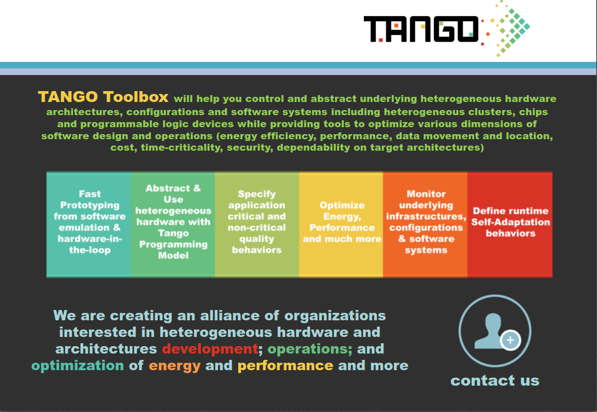Context
TANGO is a European Project belonging to the H2020-ICT-04-2015 program.
It is being undertaken by global service provider Atos and its subsidiary specialized in HPC, Bull; researchers from the University of Leeds; CETIC (Centre d’Excellence en Technologies de l’Information et de la Communication ASBL); Barcelona SuperComputing Center; and us (DELTATEC).
Project
The goal of the project is to provide technologies and tools made to facilitate the adoption of new heterogeneous hardware systems. TANGO aims at producing an energy aware development framework for parallel programming on heterogeneous hardware (GPU/CPU/FPGA – machine clusters).


Challenge(s)
Today, the importance of exploiting parallelism and heterogeneity is of increasing significance, it becomes a dominant method of delivering higher performance and improved energy efficiency. In this context, the main challenge is to provide an approach to developers that abstracts the nuances of different hardware configurations by providing programming tools that helps developers to easily benefit from system heterogeneity. In addition, performance of future application relates with not only efficient node-level execution but power consumption as well.
Solution
TANGO approach states that the energy requirements of the software applications which run on hardware units must be incorporated into the overall development and deployment process. Therefore, TANGO will address the total characterization of software with respect to the impact of software structure on power consumption and other dimensions. It defines a framework that includes, among others, a programming model, a code optimizer, a deployment engine, a self-adaption manager, a device supervisor, a device emulator…
In this project, DELTATEC brings its expertise on parallel computing, FPGA, and heterogeneous embedded systems. DELTATEC provides two realistic use cases in the project that experiment new development tools and processes. The first use case comes from our video broadcast products in which we will turn our tracking algorithm into a self-contained multi-client cloud service. The second use case comes from our embedded projects in which we will upgrade a water-meter digit recognition system using modern heterogeneous hardware architecture that includes ZYNQ, ARM and GPU components.
Our articles
- White paper: The Embedded Programming Target
- TANGO for the Embedded World
- TANGO Embedded Use Case Programming Model
